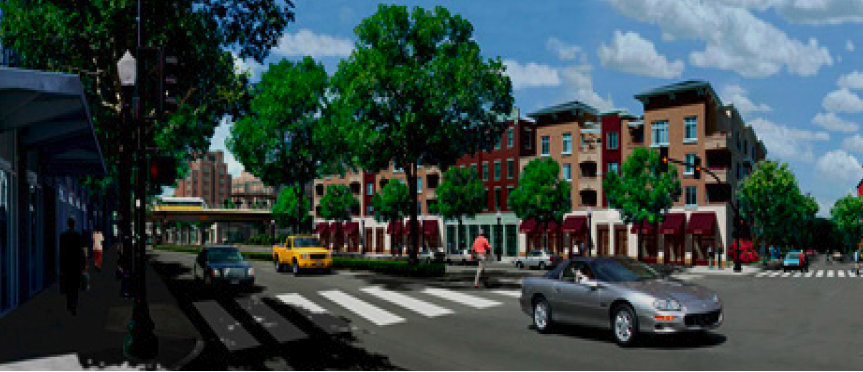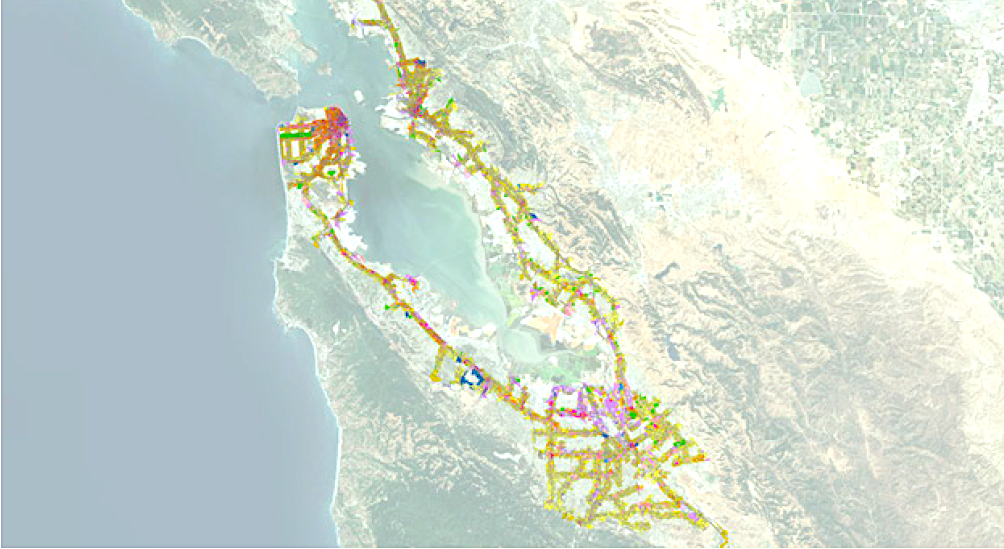Map: The El Camino strip runs 43 miles through Silicon Valley and could provide 250,000 units of housing without displacing any existing homes or apartments. And there are 543 miles of strip in the inner Bay Area lined with 16,000 acres of underused commercial land with capacity for 1.6M new households.
[Editor’s Note: In an April 4, 2020 Livable California statewide teleconference with Peter Calthorpe, author of Sustainable Communities, who popularized the transit-oriented community idea, he said fixed rail “is over” in California due to its excessive expense and mounting years of failure to deliver. He criticized bills by Sen. Scott Wiener, such as SB 827, SB 50 and now SB 902, that would disrupt vast stretches of residential communities, single-family homes, and working-class areas to build multi-unit buildings with no or few low-income units. He said: “I told Scott he had the wrong strategy, and it was going to build an opposition force that would spill over into the well-intentioned idea of infill as the only major solution to our housing problem, and that he would poison the well. And lo and behold, that’s what’s happened. We need a rational means that satisfies everyone.” Below is Mr. Calthorpe’s summary of his upcoming report, “To Solve California’s Housing Crisis, Reinvent The Strip,” published with permission of the author.]
By Peter Calthorpe
The great American strip is a relic. It was once the glue holding together the American Dream’s new world of subdivisions, shopping centers and office parks. Not unlike a lane in the grocery store, you could get anything you wanted with a quick stop, it was all there. It was the place to cruise, a new type of social space, lined with landmarks, trademarks and yes, gathering places. But no more.
We do our cruising online and much of the brick and mortar commercial life of the strip is in decay. Its lanes are now stop and go, and not for social reasons. Simultaneously, much of the West Coast is suffering from a housing crisis: a dearth of new construction, exploding costs, and very little choice.
California is the poster child of the problem with a housing shortage of two million.* Jobs grow while housing and transportation fall behind. In the Bay Area, 800,000 jobs were created while only 114,000 houses were built in the last decade. Congestion levels mount as most affordable housing slips farther and farther from the job centers in Silicon Valley and SF. Worst of all, housing is only affordable to 50% of the population. The days of spreading ever outward in suburbs too distant from jobs and too expensive for many struggling working-class households are long over. We know the only rational direction is inward; infilling, repairing, and enhancing our existing communities – and shifting from cars to walking, biking and transit. But how and where?
There are lots of housing strategies being debated and a large patchwork of infill activity ongoing – but none are moving at the scale needed. Building multifamily housing around transit stations is a popular idea and makes sense. Unfortunately, many communities reject new density in residential areas regardless of access and don’t support expensive new transit lines. Those lucky enough to have a spot in a mature community too often oppose development of any kind, hanging onto a status quo that works for them but not the next generation.
One solution offered was SB 50, state legislation to up-zone residential land around transit and in job rich areas (with exclusions for low income communities). While allowing multifamily development into single family neighborhoods may be noble and equitable, the NIMBY pitchforks and worries about displacement and gentrification helped defeat the bill. So this well-intentioned infill law needs a replacement. And while addressing housing, it did little to expand the region’s inadequate transit network.
A better approach is to redevelop the strip. A recent study by HDR and UrbanFootprint, a company producing software a bit like Sim City for real, found that the underutilized commercial land lining the Bay Area’s 540 miles of arterials totaled a whopping 16,000 acres. If redeveloped, this land could provide close to 1.6 million new houses close to jobs and existing services – the majority of it right in Silicon Valley.
While not invading residential areas or tearing down affordable apartment buildings, this commercial land could be rebuilt with mixed-use structures, keeping retail businesses on the ground floor while adding condos and apartments above. Massive infill, but not as politically toxic as residential demolition or new densities in old neighborhoods.
On these ‘Grand Boulevards’ the next generation of transit could emerge. Replacing buses on exclusive transit lanes with autonomous vans that use smart algorithms to cluster origins and destinations would provide on-call express trips 24/7. Faster and less expensive to build and operate than any current transit system, this transit tech is currently being tested in Singapore. Fehr & Peers, a leading transportation firm, estimates the construction cost at 10% of most light rail systems, with half the operating cost, all while moving passengers 30% faster. Fast, cheap, and ubiquitous may be just the ticket to get people out of their cars.
This infill strategy would upgrade the dying strip while distributing housing throughout the region without disrupting stable neighborhoods. And as a bonus, the increased property values would provide a tax windfall for public investments in transit, schools, affordable housing and local public services. Preliminary estimates show a $12.5 billion annual increase in property taxes even with 15% affordable units included. That’s 240,000 below market units as well as additional bonding capacity of close to $150 billion for new transit, infrastructure, schools and parks.
And here’s more: When compared to the impacts of an average Bay Area house, these units would generate 55% fewer auto miles; cost 53% less in utilities and transportation; consume 39% less energy; produce less carbon emissions, and demand 62% less water. A place to live that is more affordable to the environment, to households, and to our cities.
The strip is a derelict environment and an opportunity to solve our housing and transportation crisis – it is a chance to transform the leased loved part of our communities into thriving, living assets. All we need is the political will to support this transformation.
[*Editor’s note: A game-changing study by Embarcadero Institute into the number of housing units needed in California found that true need is about 1.2 to 1.4 million units, a far easier target to hit. See our post about the study, “The 3.5 Million Lie.”]


